6 High-Converting Ad Creative Examples for 2025
Creating effective ad creative is both an art and science that requires understanding target audiences at a deep level. The most compelling creative ad examples connect with viewers by addressing their specific wants, needs, desires, and fears – powerful psychological motivators that help messages break through today’s crowded digital landscape.
While ad creative has never been more important in today’s social media landscape, its fundamental purpose has remained consistent since the days of print ads and billboards: connecting with audience needs and motivating action.
This article explores various ad creative examples that effectively motivate consumer action, examining how they leverage psychological triggers to create compelling campaigns. To understand how different creative ad examples function in a comprehensive marketing strategy, we need to examine their role within the marketing funnel.
For more on how full funnel marketing works, see Full Funnel Marketing: 5 Essential Steps to Strategic Success
Creative Ad Examples in the Marketing Funnel
There are two main stages in the marketing funnel:
- Top of Funnel: New to brand users
- Bottom of Funnel: Returning users
Each stage requires a distinct messaging approach:
- Top of Funnel: Informative, Educational, Enticing
- Bottom of Funnel: Direct, Actionable, Incentivizing
While both need to align with the specific target audience, each stage serves different goals.
Top-Funnel Creative Ad Examples That Engage
Reaching people with limited knowledge of a brand, top-funnel ad creative must communicate general knowledge of a product. Each platform demands different creative approaches—video performs exceptionally well on Facebook/Instagram and TikTok Ads, while static creative dominates on Pinterest and Reddit.
When developing these creative ad examples, focus on showing the product in action or its real-world application. The key is matching your ad format to the platform’s native content style while addressing as many customer questions and hesitations as possible.
Successful top-funnel creative often blends several of the following approaches, which we’ll explore in detail:
Before/After Ads: Visualizing Transformation
A favorite of the home improvement industry, before/after ads show what life was like before purchasing a product or service, and how it was improved after.
The key with this message is to visually show the outcome of a purchase. This can be done effectively through video ads, or even through simple image comparisons like TruGreen.
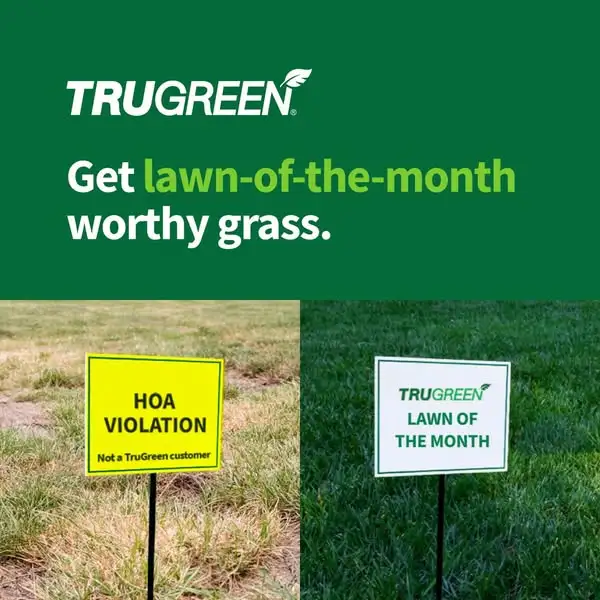
The comparison of brown grass to green grass in the background communicates the product benefits. Instead of using traditional ‘before’ and ‘after’ callouts, a lawn stake further segments the target audience: members of a homeowners’ association.
Influencer marketing presents a unique opportunity to bring before and after’s to life. Most microinfluencers are willing to take free product in exchange for a video effectively turning them into brand advocates.
Another example from TruGreen showcases a partnership with PVPlantGuy, a plant enthusiast Instagram page with 145K followers at the time of writing.
The ad combines a before/after with more traditional product demonstration to cover a broad range of customer questions. Aligning with a young influencer effectively speaks to a new homeowner audience likely to have less experience in garden care.
Product Demonstration Ads: Showing Value in Action
Product demonstration ads show a product or service in action. In the TruGreen example above, the product demonstration was the employee spraying fertilizer on the lawn.
These ads are meant to demystify the process, show in action the benefits, or answer questions that a potential customer has about how a product or service works. Done right, a product demonstration entices a user to learn more.
Creative ad examples like Ridge‘s wallet demonstration show how effective simple video ads can be for showcasing product features.
In a format perfect for social media, they show how easy the product is to use, and highlight one of it’s primary benefits – a sleek form factor that can be carried easily
Sherwin-Williams (the paint company) takes a slightly different approach – instead of promoting their product, they promote their color matching app. The ad creative shows how it takes colors from a room and matches complementary colors as options for wall colors.
This approach blends a product demo with problem/solution ad, offering a solution to the common problem of not knowing what color to pick to match a room.
Product demonstrations show how solutions work, but problem/solution ad creative examples focus first on establishing the customer’s pain point before revealing how the product addresses it.
Problem/Solution Ads: Addressing Customer Pain Points
Problems are at the core of all marketing messaging. Most products or services solve problems, and this type of creative is aimed at communicating just that.
The key with this message is to identify the most common problem faced by customers. This can be done through surveying, or customer sentiment analysis – see How to Turn AI Into a Customer Sentiment Analysis Tool for a detailed guide.
Bilt has a great example of a problem/solution framework. Their service allows renters to pay their rent using a credit card, effectively accruing points that can be spent on anything from travel to daily expenses.
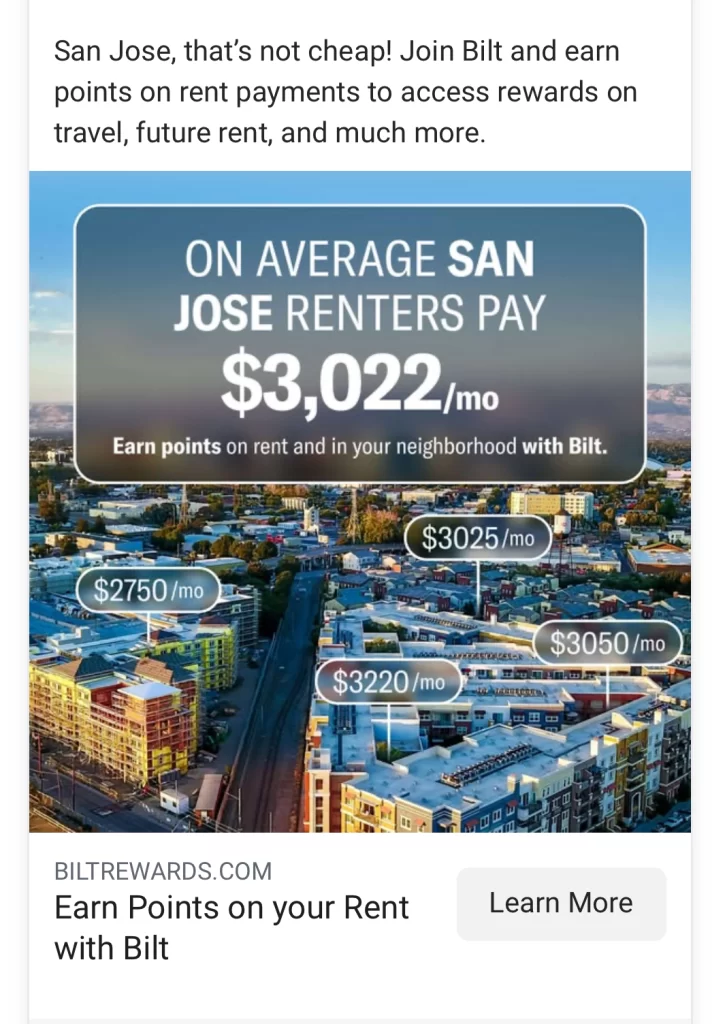
Not only is this ad personalized to the user’s home city, but it addresses a crucial problem – rent is expensive.
The solution to gain credit card points on an expense that most people don’t presents a unique opportunity, enticing the user to click-through and learn more.
Olipop, a soda pop brand, has a more subtle take on problem solution ads. Rather than call out the problem, they call out the benefits of their soda: high in fiber, low sugar.
Most people know that soda is very sugary, so this provides a unique and healthier alternative without needing to call out traditional soda as ‘bad’.
While these ad creative examples excel at introducing new audiences to your brand, a different approach is needed when targeting users who are already familiar with your offering and considering a purchase.
Bottom-Funnel Ad Creative Examples That Drive Conversion
Focusing on individuals that are already considering a purchase shifts the narrative. Instead of education, the goal becomes driving action.
Ad format matters less – a static and video ad are both acceptable – but the key becomes using a strong call to action. A call to action is the action you want the user to take after engaging with your ad.
Calls to action (CTAs) are often direct (learn more, buy now), but still need to be tie to relevant information about the product or service to continue to persuade potential customers to make a purchase. This can be done through several means.
Incentive Ads: Motivating Quick Action
Incentives are as old as marketing itself. The concept involves offering some form of discount, promotion, or add-on to speed up the decision making process.
Incentive ads are particularly common in the fashion and skincare industries due to the high potential lifetime value of a customer. See Setting Marketing Goals: Starting with Business Metrics for a deep dive on how Lifetime Value works in marketing measurement.
Brickell, a men’s skincare brand, uses a unique incentive to introduce customers to their product – a starter kit with sample sizes of all their products.
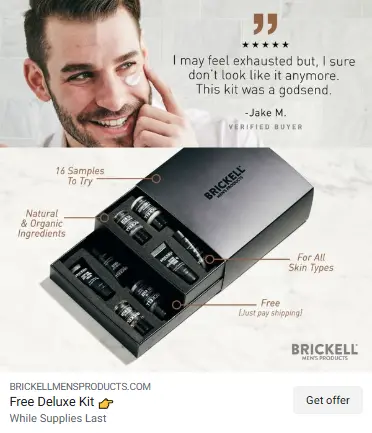
While the user pays nothing for the product (just shipping), it gives the brand a chance to prove the value of their products through actual use. It’s no secret that once you try a product, the chances of buying it again increase significantly.
They are relying on the quality of product to be the driver of future sales, and clearly it works well for them. This particular incentive has been running for years.
Another great example of incentive ads comes from Lululemon. Instead of including the incentive in their ad, it’s woven into the ad copy.
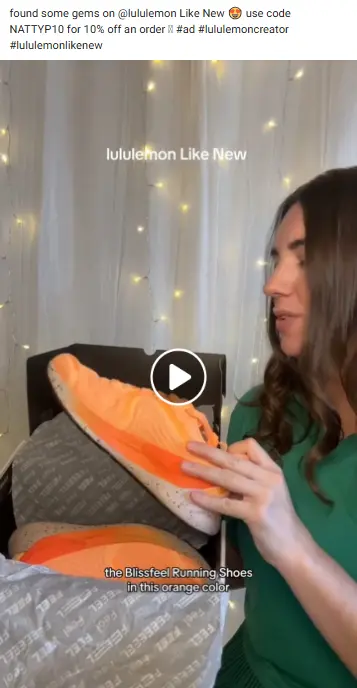
Including a promo code in ad copy gives users that stop and read the ad an extra little push to click-through. This is particularly effective when used in retargeting as there is already some familiarity with the website experience.
Urgency Ads: Creating Action Through Scarcity
Urgency ads reinforce the need to act quickly through the use of scarcity, creating a sense of limited or desirable sense in a product. This can be done through several means, but most often involves the use of a time sensitive promotion.
Holiday sales are a great example of this. To secure a good discount or rate, a buyer must act before the end of the seasonal promotion.
Lowes promotes their Spring Fest as a limited time offer to score a deal on popular products.

This ad does a great job of combining an incentive with urgency to drive action. Another example of urgency comes from a client I’ve personally worked on.
COREtec, a flooring manufacturer, was ending their promotional free flooring samples which resulted in a great opportunity to leverage urgency. We ran ads across Google Ads and social media messaging the end of the promotion, and a call to ‘order before it’s too late’.
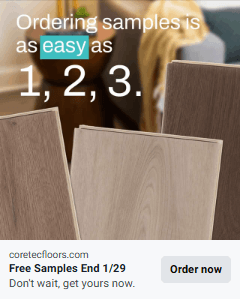
With this approach, we were able to drive the highest single month of sample orders ever recorded in their company history, as well as a 25% decrease in the cost per sample order compared to the prior year.
While urgency ads are a short term strategy, they can be leveraged periodically throughout the year with well timed sales and promotions.
The final ad type is an evergreen strategy and one that is imperative in service-based businesses.
Testimonial Ads: Building Trust Through Social Proof
In an increasingly skeptical marketplace, testimonial ads represent one of the most powerful forms of creative ad examples. By showcasing real customer experiences and results, these ads build credibility and overcome buyer hesitation.
Athletic Greens opts for a celebrity testimonial knowing it is aligned with their audience.
Not only does Dr. Huberman state that he uses the product, but that he experiences specific benefits and recommends it to anyone.
Real customer reviews can also be a powerful source of testimonials, as well as much more cost-effective. Safelite uses reviews to create a simple image ad that touts exceptional customer service.

As these creative ad examples demonstrate, effective advertising requires understanding both your audience’s needs and where they are in their buyer’s journey. Implementing these frameworks in your own campaigns requires strategic planning and clear objectives.
Implementing Effective Ad Creative
When incorporating these creative ad examples into your strategy, start with one framework for each funnel stage. For top-of-funnel awareness, consider problem/solution or product demonstration formats that educate new audiences. For bottom-of-funnel conversion, leverage testimonials or urgency tactics that drive immediate action.
Whether developing video ads for social media or image ads for various platforms, start by understanding your audience, then craft messaging addressing their pain points. The most successful ad creative often blends multiple approaches—combining testimonials with urgency, or demonstrating products while highlighting specific problems they solve. This versatility in ad format allows you to connect with potential customers throughout their buying journey.
As advertising platforms evolve, continue testing different creative approaches. Start with these frameworks, measure what resonates with your audience, and refine your ad creative strategy for optimal performance.
